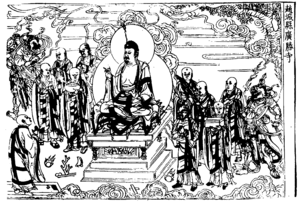Zhaocheng Jin Tripitaka
Appearance

The Zhaocheng Jin Tripitaka (Chinese: 趙城金藏) is a Chinese copy of the Buddhist canon dating from the Jin dynasty (1115–1234).
The Jin Tripitaka was originally created at the Tianning Temple in Shanxi province around 1149, funded by donations from a woman named Cui Fazhen and her followers.[1] It was presented by Kublai Khan to the Guangsheng Temple in Pingyang, where it was rediscovered in 1933.[2] Since the Guangsheng Temple is located in Zhaocheng, the document was renamed the Zhaocheng Jin Tripitaka.[1]
With around 7,000 chapters, it is the longest extant printed work of the Jin dynasty.[3] It contains a number of sutras which are missing from subsequent editions of the canon.[1]
Wikimedia Commons has media related to Zhaocheng Jin Tripitaka.
References
[edit]- ^ a b c Cui, Fazhen (1149). "The Zhaocheng Jin Tripitaka". World Digital Library (in Chinese). Shanxi Sheng, China. Retrieved 28 May 2013.
- ^ Asia Society; Chinese Art Society of America (2000). Archives of Asian art. Asia Society. p. 12. Retrieved 28 May 2013.
- ^ Luo Shubao (1998). Illustrated history of printing in ancient China. Wenwu Publishing House. p. 64. ISBN 978-7-5010-1042-4.
